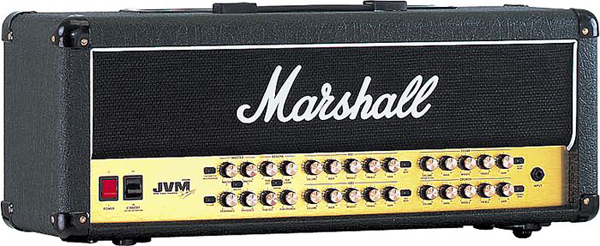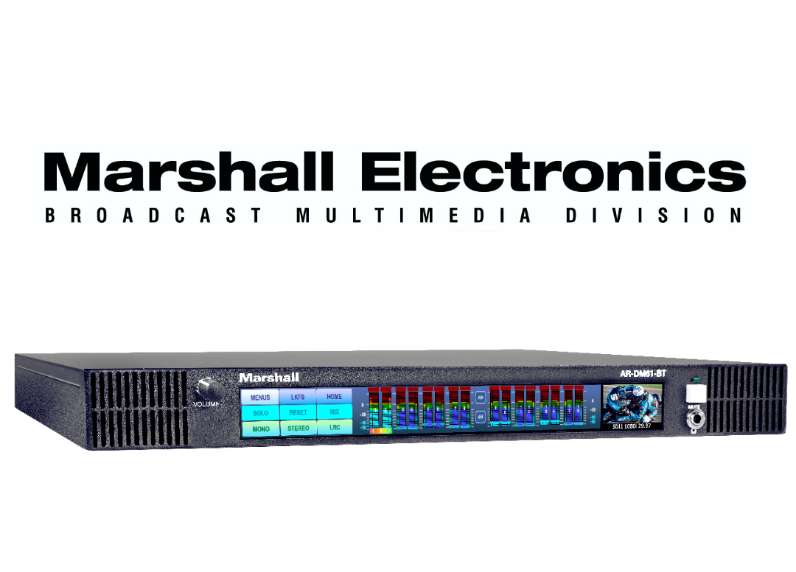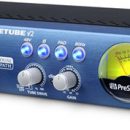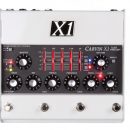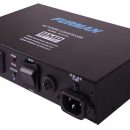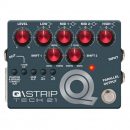 For as long as we can remember, Marshall has been one of the names at the top of the list when people think of rock music and guitar amps. Between the endless list of artists who play them and the sonic tonal characteristics that have made them an industry staple, redefining the flagship model in the amp line is a scary proposition.
For as long as we can remember, Marshall has been one of the names at the top of the list when people think of rock music and guitar amps. Between the endless list of artists who play them and the sonic tonal characteristics that have made them an industry staple, redefining the flagship model in the amp line is a scary proposition.
The Marshall JVM410H was born with the expectation not only to compare favorably with its classic brothers of yesteryear, but also to have a voice of its own and actually take things to the next level. After spending a month with the new British beauty, it seems that Marshall has been successful in bringing us a great update to a product line that so many of us have enjoyed playing for years.
| Category | Value | Rating |
| Features | 20% | |
| Usability | 25% | |
| Sound | 25% | |
| Documentation & Support | 10% | |
| Price | 20% | |
| OVERALL RATING = 3.7, which earns it a WIHO Award! 3.6 stars or better: Outstanding, WIHO Award 3 stars or better: Worth considering 2 stars or better: Suited to specific needs 1 star or less: Not recommended |
||
If you have a deep spot in your heart for that world-renowned Marshall tone, the Marshall JVM410H is sure to blow your mind with its vast array of flexibility (four channels with multiple voicings each), programming options (MIDI control!) and newfound levels of gain to suit any EL-34 lover’s sonic preference. Besides delivering everything from classic Marshall rock tone to new high-gain Marshall madness, the JVM410H delivers something else particularly impressive... this Marshall does great cleans! That’s right — it features a clean channel that really shows no sign of overdrive or breakup in signal, and across all channels in this versatile amp, noise has been reduced to new levels of low.
Features
The Marshall JVM410H is a 100 watt, all-tube power amplifier head containing five ECC83 preamp tubes and four EL-34 power tubes. Of typical Marshall build quality and design (and made in England), the JVM410H weighs in at approximately 48 lbs and measures 29.55” L x 8.47” W x 12.21” H.
The amp contains four separate channels named Clean, Crunch, OD1 (Overdrive 1) and OD2 (Overdrive 2.) Each Channel contains basic control features including Volume, Bass, Middle, Treble and Gain. The knobs only go to Ten, but don’t worry — you can still play songs in D-minor (the saddest of keys, you know).
Within each channel, a Mode button provides selection of three different mode settings corresponding to gain stages within each channel. The current mode is identified by an LED within the selection button. The nicely color-coded modes are Green, Orange, and Red, which also are identifiable in the same manner on the footswitch via matching LEDs. Not only do you have a dedicated button on the foot controller for selecting each channel, but pressing on the same channel switch consecutively will scroll you through the three different mode settings (gain stages) within that channel.
The JVM410H is equipped with independent level controls for the onboard digital reverb on each of the individual channels. Also within each channel/mode, you can program whether the reverb should be active or bypassed. This function is accessible via a button with a red LED to identify On/Off status and has a corresponding control button and LED on the footswitch.
The Master control section of the JVM410H contains Master Volume 1, Master Volume 2, Resonance, and Presence controls. Master Volumes 1 and 2 are assignable to each of the channels, so two different volume levels are always on tap, useful for soloing or bringing out your clean channel if extra volume is needed at a moment’s notice.
 The footswitch is quite an impressive little black box! The rugged metal footswitch is equipped with six-way programmable Carling-style buttons and seven LEDs labeled Clean, Crunch, OD1, OD2, Master, Reverb and FX. The LEDs correspond with the LEDs found on the JVM410H relating to each control function on the amplifier head itself.
The footswitch is quite an impressive little black box! The rugged metal footswitch is equipped with six-way programmable Carling-style buttons and seven LEDs labeled Clean, Crunch, OD1, OD2, Master, Reverb and FX. The LEDs correspond with the LEDs found on the JVM410H relating to each control function on the amplifier head itself.
The footswitch operates in two different modes:
- Switch Store Mode: Enables you to assign any of its six switches to instantly recall any front panel function.
- Preset Store Mode: Enables you to recall a complete channel setup in any order or combination.
The JVM410H is equipped with digital reverb routed in parallel to the main signal and mixed by means of a valve (tube). When engaged, there is no degradation of the direct signal, and when disengaged, the effect is completely bypassed.
This versatile head is equipped with a Silent Recording Mode. This enables you to put the amp on standby, which disengages the power amp stage of the amp, but leaves the rest of the amp totally functional. Via an Emulated Line Out (XLR connection), the sound output simulates that of a 4x12 cabinet for direct recoding or live performance applications.
Where would we be without effects loops? The JVM410H provides all the guns necessary for your personal preference or choice of application. Armed with two loops, you have a choice between Serial/Parallel FX Loop and Power Amp Insert/Serial Loop. In other words, one loop can be set for either parallel or series operation, and the second loop is just wired in series. Also provided are an FX Level control button to choose between +4 dBu and -10 dBu depending on application, and a Mix control knob for wet/dry level adjustments.
Five speaker outputs are available for providing connections to multiple speaker cabinets in popular 16-ohm, 8-ohm and 4-ohm configurations.
The JVM410H also contains MIDI IN and MIDI Thru connections should you have a need to interface with your complex rig. A Footswitch and MIDI Program button are located on the front of the amplifier to enter the programming mode for this application.
Usability
The Marshall JVM410H is loaded with features, and sometimes, having all the bells and whistles in an amp can be a bit overwhelming when the layout is cluttered. Fortunately, the JVM410H is laid out extremely well, grouping each Channel, Reverb, and Master control in a clearly identifiable manner.
At first glance, we noticed the arrangement of the controls, reading from left to right: Master control section, Reverb section, Channel OD1 and OD2 and lastly Channel Clean and Crunch – the order struck us as being backwards. On the JVM410C combo amp version of the JVM, the controls were set up in reverse, which actually makes more sense when taking into consideration the additional gain stages and the order in which you would usually build your sound. We suspect that the more-intuitive-but-reversed layout in the combo has to do with orienting the logic board upside down within the combo’s cabinet for space considerations, but either way, we got used to the arrangement quickly.
The Marshall JVM410H was extremely easy to use and intuitive, leaving us more time to play the amp rather than having to resort to the owner’s manual every time we needed to make a change. Taking into account the number of push-buttons and digital programming available per each channel and mode setting (twelve options in all,) the JVM really was simple to use, mainly due to its automatic memory function.
Making a setting selection change via any of the On/Off or Mode selection buttons was automatically remembered for recall at any time. There isn’t any Save button to push nor none of that “push that button while holding this button” nonsense — one button/one function with automatic recall memory. Simple!
Operation of each channel section is quite simple and straightforward using standard controls including Volume, Bass, Middle, Treble, and Gain. The only slight difference was that on Channel 1 (Clean Channel), the Volume knob was only engaged with the Orange and Red modes allowing for overdrive. In the Green mode, only the Gain control knob is engaged to eliminate the ability to overdrive the clean channel.
The Master control section of the JVM410H provides two separate Master Volume controls and global Presence and Resonance controls. The Master Volume controls 1 and 2 are assignable to any of the twelve available modes within the four channels. This gave us the ability to program specific volume requirements between our rhythm and lead settings.
The Resonance and Presence control features are only applicable when using an actual speaker cabinet and had no effect when using the Emulated Line Out for recording. Using the Resonance control gave us the ability to adjust the amount of bass response resonated by the speaker. The Presence control allowed us to emphasize the speaker’s high frequency response which adds presence to the sound. In using both of the controls, the Resonance control enabled us to obtain just the right amount of Marshall low-end punch while the Presence control enabled us to dial in enough high end to provide a cutting edge without becoming too brittle.
Moving to the back control panel of the Marshall JVM410H, we found a number of preferred usable features. Our favorite feature was the input jack for connecting the foot-controller. We know... how could there be excitement about something so boring? It was simple to identify which jack connection to plug into without actually looking behind the amp and reading the markers. The footswitch input jack is marked by a white attachment nut making it extremely easy to identify and connect.
The footswitch for the JVM410H was extremely easy to use and operate due to its standard 1/4” guitar cable connection from head to controller and matching color-coded LEDs.
Another great feature was the ability to make connections between our favorite MIDI foot-controller. We connected a Lexicon MPX R1 MIDI foot controller to the JVM for testing and things worked perfectly without any complex configuration — Marshall couldn’t have made connection of this device any easier. Pressing the MIDI Program button twice on the front of the JVM410H put the amplifier in a learning mode, causing indicated by a flashing LED. Once the MIDI program change command was received, the current settings (including Channel, FX, Reverb and Master) were stored at the current MIDI program number. The JVM410H provides storage and instant recall for 128 presets when used with a foot controller — awesome!
Sound
The Marshall JVM410H is filled with vintage, classic Marshall tones as well as modern high-gain tones that should help you down the path to rock and roll stardom. With four channels and three switchable modes per channel (twelve options in all), you are sure to find a sound suitable to any musical situation.
We tested the Marshall JVM410H through a few cabinets: the Marshall 1936a 2x12 (Celestion G12T-75 speakers) and a Marshall 1960C 4x12 cabinet (Celestion Greenback G12M-25 speakers). Guitars used for the testing included a humbucker-equipped Music Man JP6 and a single-coil Fender Deluxe Stratocaster.
No matter which guitar pickup configuration you take privy to, the JVM410H has more than enough – MORE THAN ENOUGH! – gain stages to achieve just the right amount of heaviness you may be looking for.
The very first noticeable difference with this Marshall head compared to other Marshall amps that we’ve owned or played was how quietly it performed. With earlier models, you could hear the hiss and hum of the power wanting to be unleashed. Not so with the JVM410H. Stealth-like, this amp performed much quieter than its predecessors. And that dirt found in most Marshall clean channels? Forget about it — the clean Channel 1 in the JVM410H is anything but dirty. We were able to obtain crystal clear cleans in the Green Mode setting, punchy and glassy overdriven blues in the Orange Mode setting, and nice tight crunch in the Red Mode setting of Clean Channel 1.
Channel 2 provided multiple stages of crunch. In the first stage (Green mode) setting, the crunch was reminiscent of the classic JTM45 and 1959 Plexi models — very defined and tight. Marshall explains this stage as “gain plus gain plus tone” — two gain stages, presumably.
The Orange Mode in channel 2 was similar in tone to that of a Marshall JCM800. The gain structure here features three gain stages plus tone, and was most identifiable to us when we think of Marshall’s traditional rock and roll tone.
The Red mode, you ask? – This is where you get into tones that you’d expect from typical Marshal amp mods of yesterday when players needed a little more drive and gain. Reminiscent of a hot-rodded JCM800, we were able to obtain that long sustaining, cascading overdrive tone desired for singing lead lines in todays modern rock.
Okay, lets fasten our seat belts... things are about to get slammin’ heavy. The third channel, OD1 (Overdrive Channel 1) begins to take us into crunch, crossing over to distortion heaven. Again, with three stages of gain, options available via the Mode switch, we can’t imagine not finding a tone to suits your taste unless you are specifically partial to the performance characteristics of 6L6 power tubes.
In channel OD1/Green mode, we got the exact same sound/tone as in Crunch Channel 2/Red mode, comparable to that of a hot-rodded JCM800. This allowed us to dial in two similar, but distinctive, crunch sounds. In Orange mode, the gain stage was increased, providing a sound suitable for singing leads and heavy rhythms. This was beautifully suited to playing modern metal music.
Red mode provided additional gain, but still retained note clarity and definition.
The fourth Channel, OD2 (Overdrive 2), ignores seat belts in favor of full body harnesses, and maybe a space suit as you get blasted into the stratosphere of gain. Incredible — this had to be just about the most gain we’ve ever heard come out of any amp we’ve ever played. As we alluded to earlier, there’s no need for this amp to go to eleven — Nigel would have been content at, um... four!
Still reminiscent of that pumping Marshall tone, shifting through each Mode setting (Green, Orange and Red) gave us a never-ending cascade of smooth, glistening sustain. We had to work a little harder to control any unwanted feedback during the times we were sitting idle, though. This channel demands to be played and wants to ring out with all possible harmonics. In Red mode, notes were still distinguishable, almost acting as if there was a separation between the actual note and gain effect. We were able to increase gain to add color to our sound without loosing the integrity and definition of the note — wonderful! This high gain channel really was like a sheet of ice – smooth and glistening, yet able to melt the hardest composite of metal.
One big concern for many players today was the introduction of digital reverb into the Marshall JVM410H. Never before has Marshall integrated a digital reverb unit into one of their tube amps. Fortunately, we found the Reverb section of the JVM410H to be very effective, and it provided excellent studio-quality sound. At all levels from low to high, the reverb provided an excellent mix and decay. The routing of the digital reverb in parallel to the main signal and mixed through a valve (tube) ensured a natural decay during channel switching — we never experienced popping sounds or dropouts during channel switching.
Both the serial and parallel effects loops provided clean signal processing during use.
The Marshall JVM410H, equipped with a Simulated Line Out, provided excellent direct signal processing emulating a 4x12 cabinet. We tested the Simulated Line Out going direct into our recording console. This feature did a great job emulating a “typical” Marshall 4x12 cabinet retaining a three dimensional speaker sound including the punch and thud you would normally hear during a live application. The signal remained clean due to the pre-master volume stage and being electronically balanced for this recording application, and was well-suited to direct recording, PA use without the hassle of miking, and of course, preserving beautiful Marshall tone when playing while the rest of the family was asleep!
Documentation and Product Support
The Marshall JVM410H comes with a very comprehensive Owner’s Manual providing everything from a basic overview of all features to detailed operational directives and closing out with helpful hints and tips. We found the documentation extremely helpful in getting acquainted with some of the not-so-obvious functions of this knockout of an amp.
The one piece of information we missed was a supply of some sample settings to get started. We find suggested settings to be useful starting points for our sonic exploration, and they sometimes reveal sonic options that wouldn’t have occurred to us on our own.
In addition, Marshall provides excellent reference materials and customer service options via their website.
Price
The Marshall JVM410H ($2,559.00 MSRP) can be found for approximately $1,800. It is well worth the price, taking into consideration the vast menu of features including all tube technology, four separate programmable channels with multiple gain options, a Simulated Line Out for direct recording, MIDI control, etc.
Contact Information
Marshall Amplification
www.marshallamps.com
Evaluation Short-List
EVH 5150 III
Mesa/Boogie Dual Rectifier Roadking II

